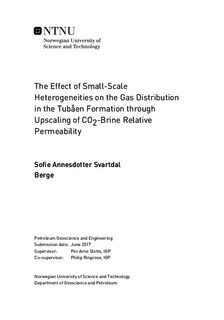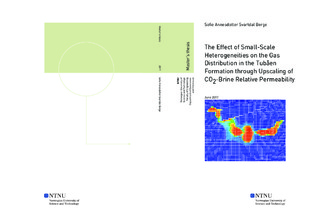| dc.description.abstract | The Tubåen Formation in the Norwegian Sea is an aquifer and was used by Statoil ASA as the injection reservoir for CO2 separated from produced gas at Snøhvit in the time period between April 2008 until it was abandoned in April 2011. The CO2 injection and plume development is currently described with a simulation model using only one set of isotropic, un-scaled flow functions, i.e. the potential for a more accurate simulation model is great. This thesis investigate how upscaled flow functions affect the dynamic behaviour in the reservoir. Different upscaling techniques are used and compared by looking at how they affect the CO2 plume development in the formation. All models used in this thesis are the property of Statoil ASA.
Lithofacies models with small scale hetereogeneities typical for the Tubåen formation, Wavy and Flaser, are made to fit each of the zones in Tubåen before the flow functions are upscaled in the models using the upscaling techniques Capillary Equilibrium and Viscous Limit. The upscaling is performed by the Upscaling Module in the open source software Open Porous Media.
The resulting relative permeability curves clearly show that the small scale heterogeneities and upscaling technique affect the two-phase flow. In the final step the upscaled flow functions are used in various combinations as input in the full scale simulation model of the Tubåen Formation. A set of models with various combinations of upscaled flow functions are made to be able to distinguish between geology effects in the reservoir and relative permeability effects on the CO2 distribution. All models with upscaled curves are also compared to the Basecase with a single set of isotropic, un-scaled flow functions.
The results are that small scale geological heterogeneities, demonstrated by Wavy and Flaser bedding, are found to greatly affect the development of the plume, and most so Wavy bedding. The choice of upscaling technique, Capillary Equilibrium or Viscous Limit, is also found to be of great importance for the CO2 distribution - especially in the gravitational dominated period after injection stop. The Capillary Equilibrium option shows a greater impact on the relative permeability curves than the Viscous Limit option, but both lead to reduced vertical relative permeability of CO2.
Besides the upscaling work itself, the process of creating relative permeability curves for upscaling and adjusting the lithofacies models and the full scale model are described in detail. | |

